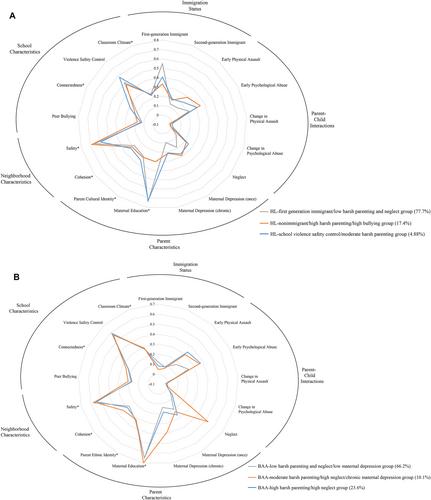Toward an optimized assessment of adolescent psychopathology risk: Multilevel environmental profiles and child irritability as predictors
Abstract
Background
Adolescence is a developmental period during which youth experience vulnerability to psychopathology. To build the foundation for a parsimonious psychopathology risk calculator while capturing the complexity and dynamic nature of the environment, the current study aimed to identify distinct risk and resilience profiles with a wide range of environmental factors guided by Bronfenbrenner's biopsychosocial ecological system theory. The association between the early-mid childhood risk profiles and psychopathology in adolescence were examined. Moreover, the predictive utility of early childhood irritability was evaluated in addition to the risk profiles.
Methods
The data from Future of Families and Child Wellbeing Study a nation-wide longitudinal study, were used in the latent profile analyses to identify the risk profiles with family, school, and neighborhood characteristics from 3 to 9 years old. To capture the socio-environmental and cultural nuances, we extracted three subsamples, including Black/African American (n = 2587), Hispanic/Latinx (n = 1577), and White (n = 776) for separate analyses. Risk profile memberships were used to predict adolescence psychopathology, including depression, anxiety, attention deficits, oppositional defiant disorder, and conduct disorder symptoms. The predictive utility of early childhood irritability above and beyond environmental risk profiles was evaluated using stepwise regression.
Results
Three risk profiles were identified in the Hispanic/Latinx and Black/African American subsamples, while four profiles were identified in White subsample. Almost all risk profile membership predicted both internalizing and externalizing psychopathology, while some profiles are predictive of externalizing symptoms only. Higher level of irritability predicted higher symptomatology in all five mental health outcomes above and beyond the environmental profiles.
Conclusions
Distinct risk and resilience profiles primarily driven by parent and family characteristics were identified for all three major race/ethnicity groups. Our findings lay the foundation for a more efficient multi-tiered information gathering process in mental health clinical settings to aid the decision making for intervention and prevention.


 求助内容:
求助内容: 应助结果提醒方式:
应助结果提醒方式:


